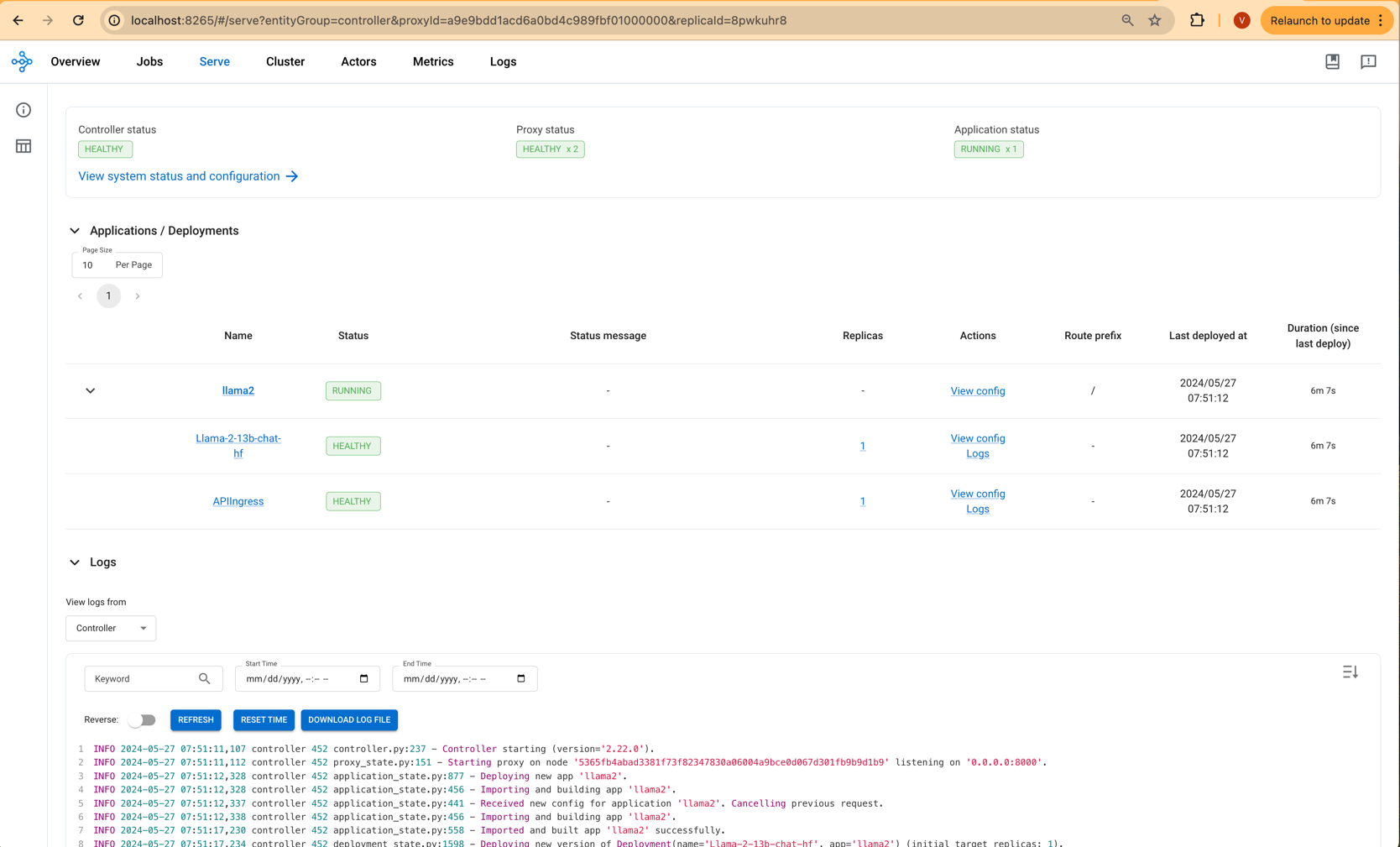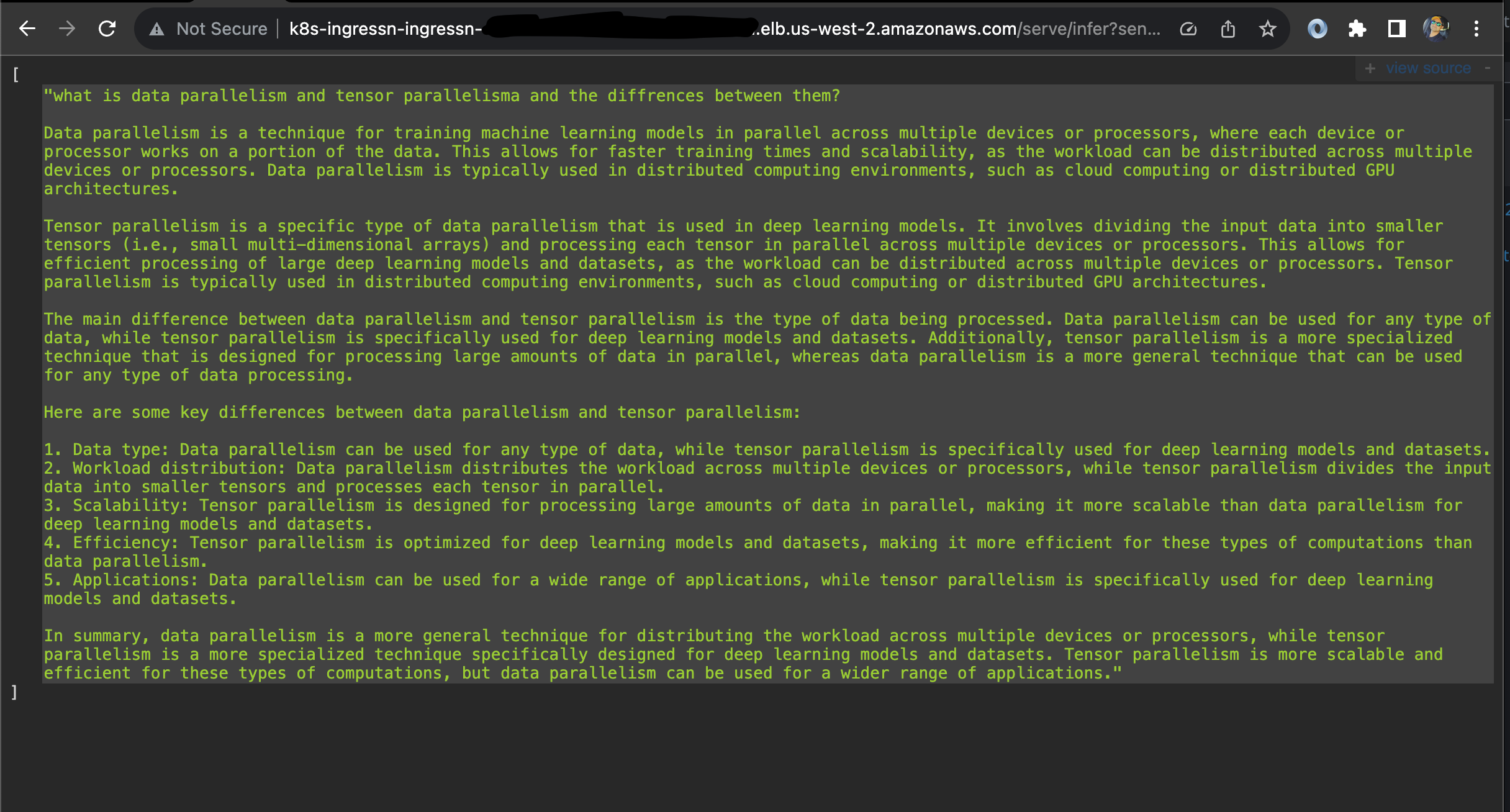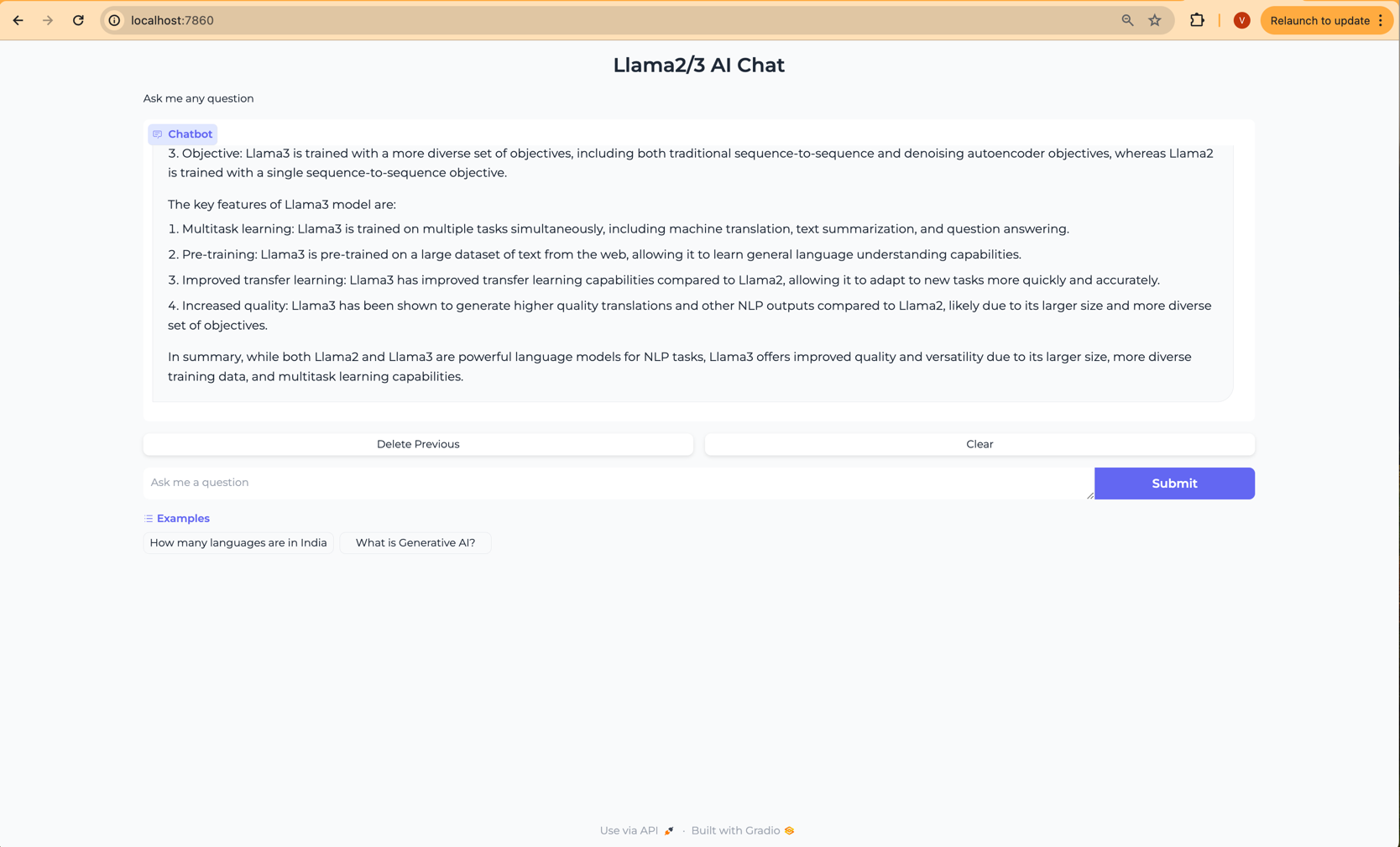The AI on EKS content is being migrated to a new repository. 🔗 👉 Read the full migration announcement »
Deployment of ML models on EKS requires access to GPUs or Neuron instances. If your deployment isn't working, it’s often due to missing access to these resources. Also, some deployment patterns rely on Karpenter autoscaling and static node groups; if nodes aren't initializing, check the logs for Karpenter or Node groups to resolve the issue.
Note: Use of this Llama-2 model is governed by the Meta license. In order to download the model weights and tokenizer, please visit the website and accept the license before requesting access.
We are actively enhancing this blueprint to incorporate improvements in observability, logging, and scalability aspects.
Serving Llama-2-13b Chat Model with Inferentia, Ray Serve and Gradio
Welcome to the comprehensive guide on deploying the Meta Llama-2-13b chat model on Amazon Elastic Kubernetes Service (EKS) using Ray Serve.
In this tutorial, you will not only learn how to harness the power of Llama-2, but also gain insights into the intricacies of deploying large language models (LLMs) efficiently, particularly on trn1/inf2 (powered by AWS Trainium and Inferentia) instances, such as inf2.24xlarge and inf2.48xlarge,
which are optimized for deploying and scaling large language models.
What is Llama-2?
Llama-2 is a pretrained large language model (LLM) trained on 2 trillion tokens of text and code. It is one of the largest and most powerful LLMs available today. Llama-2 can be used for a variety of tasks, including natural language processing, text generation, and translation.
Llama-2-chat
Llama-2 is a remarkable language model that has undergone a rigorous training process. It starts with pretraining using publicly available online data. An initial version of Llama-2-chat is then created through supervised fine-tuning.
Following that, Llama-2-chat undergoes iterative refinement using Reinforcement Learning from Human Feedback (RLHF), which includes techniques like rejection sampling and proximal policy optimization (PPO).
This process results in a highly capable and fine-tuned language model that we will guide you to deploy and utilize effectively on Amazon EKS with Ray Serve.
Llama-2 is available in three different model sizes:
- Llama-2-70b: This is the largest Llama-2 model, with 70 billion parameters. It is the most powerful Llama-2 model and can be used for the most demanding tasks.
- Llama-2-13b: This is a medium-sized Llama-2 model, with 13 billion parameters. It is a good balance between performance and efficiency, and can be used for a variety of tasks.
- Llama-2-7b: This is the smallest Llama-2 model, with 7 billion parameters. It is the most efficient Llama-2 model and can be used for tasks that do not require the highest level of performance.
Which Llama-2 model size should I use?
The best Llama-2 model size for you will depend on your specific needs. and it may not always be the largest model for achieving the highest performance. It's advisable to evaluate your needs and consider factors such as computational resources, response time, and cost-efficiency when selecting the appropriate Llama-2 model size. The decision should be based on a comprehensive assessment of your application's goals and constraints.
Inference on Trn1/Inf2 Instances: Unlocking the Full Potential of Llama-2
Llama-2 can be deployed on a variety of hardware platforms, each with its own set of advantages. However, when it comes to maximizing the efficiency, scalability, and cost-effectiveness of Llama-2, AWS Trn1/Inf2 instances shine as the optimal choice.
Scalability and Availability
One of the key challenges in deploying large language models (LLMs) like Llama-2 is the scalability and availability of suitable hardware. Traditional GPU instances often face scarcity due to high demand, making it challenging to provision and scale resources effectively.
In contrast, Trn1/Inf2 instances, such as trn1.32xlarge, trn1n.32xlarge, inf2.24xlarge and inf2.48xlarge, are purpose built for high-performance deep learning (DL) training and inference of generative AI models, including LLMs. They offer both scalability and availability, ensuring that you can deploy and scale your Llama-2 models as needed, without resource bottlenecks or delays.
Cost Optimization: Running LLMs on traditional GPU instances can be cost-prohibitive, especially given the scarcity of GPUs and their competitive pricing. Trn1/Inf2 instances provide a cost-effective alternative. By offering dedicated hardware optimized for AI and machine learning tasks, Trn1/Inf2 instances allow you to achieve top-notch performance at a fraction of the cost. This cost optimization enables you to allocate your budget efficiently, making LLM deployment accessible and sustainable.
Performance Boost While Llama-2 can achieve high-performance inference on GPUs, Neuron accelerators take performance to the next level. Neuron accelerators are purpose-built for machine learning workloads, providing hardware acceleration that significantly enhances Llama-2's inference speeds. This translates to faster response times and improved user experiences when deploying Llama-2 on Trn1/Inf2 instances.
Model Specification
The table provides information about the different sizes of Llama-2 models, their weights, and the hardware requirements for deploying them. This information can be used to design the infrastructure required to deploy any size of Llama-2 model. For example, if you want to deploy the Llama-2-13b-chat model, you will need to use an instance type with at least 26 GB of total accelerator memory.
| Model | Weights | Bytes | Parameter Size (Billions) | Total Accelerator Memory (GB) | Accelerator Memory Size for NeuronCore (GB) | Required Neuron Cores | Required Neuron Accelerators | Instance Type | tp_degree |
|---|---|---|---|---|---|---|---|---|---|
| Meta/Llama-2-70b | float16 | 2 | 70 | 140 | 16 | 9 | 5 | inf2.48x | 24 |
| Meta/Llama-2-13b | float16 | 2 | 13 | 26 | 16 | 2 | 1 | inf2.24x | 12 |
| Meta/Llama-2-7b | float16 | 2 | 7 | 14 | 16 | 1 | 1 | inf2.24x | 12 |
Example usecase
A company wants to deploy a Llama-2 chatbot to provide customer support. The company has a large customer base and expects to receive a high volume of chat requests at peak times. The company needs to design an infrastructure that can handle the high volume of requests and provide a fast response time.
The company can use Inferentia2 instances to scale its Llama-2 chatbot efficiently. Inferentia2 instances are specialized hardware accelerators for machine learning tasks. They can provide up to 20x better performance and up to 7x lower cost than GPUs for machine learning workloads.
The company can also use Ray Serve to horizontally scale its Llama-2 chatbot. Ray Serve is a distributed framework for serving machine learning models. It can automatically scale your models up or down based on demand.
To scale its Llama-2 chatbot, the company can deploy multiple Inferentia2 instances and use Ray Serve to distribute the traffic across the instances. This will allow the company to handle a high volume of requests and provide a fast response time.
Solution Architecture
In this section, we will delve into the architecture of our solution, which combines Llama-2 model, Ray Serve and Inferentia2 on Amazon EKS.

Deploying the Solution
To get started with deploying Llama-2-13b chat on Amazon EKS, we will cover the necessary prerequisites and guide you through the deployment process step by step.
This includes setting up the infrastructure, deploying the Ray cluster, and creating the Gradio WebUI app.
Prerequisites
👈Deploying the Ray Cluster with Llama-2-Chat Model
Once the Trainium on EKS Cluster is deployed, you can proceed to use kubectl to deploy the ray-service-Llama-2.yaml.
In this step, we will deploy the Ray Serve cluster, which comprises one Head Pod on x86 CPU instances using Karpenter autoscaling, as well as Ray workers on Inf2.48xlarge instances, autoscaled by Karpenter.
Let's take a closer look at the key files used in this deployment and understand their functionalities before proceeding with the deployment:
-
ray_serve_Llama-2.py: This script uses FastAPI, Ray Serve, and PyTorch-based Hugging Face Transformers to create an efficient API for text generation using the NousResearch/Llama-2-13b-chat-hf language model. Alternatively, users have the flexibility to switch to the meta-llama/Llama-2-13b-chat-hf model. The script establishes an endpoint that accepts input sentences and efficiently generates text outputs, benefiting from Neuron acceleration for enhanced performance. With its high configurability, users can fine-tune model parameters to suit a wide range of natural language processing applications, including chatbots and text generation tasks.
-
ray-service-Llama-2.yaml: This Ray Serve YAML file serves as a Kubernetes configuration for deploying the Ray Serve service, facilitating efficient text generation using the
Llama-2-13b-chatmodel. It defines a Kubernetes namespace namedLlama-2to isolate resources. Within the configuration, theRayServicespecification, namedLlama-2-service, is created and hosted within theLlama-2namespace. TheRayServicespecification leverages the Python scriptray_serve_Llama-2.py(copied into the Dockerfile located within the same folder) to create the Ray Serve service. The Docker image used in this example is publicly available on Amazon Elastic Container Registry (ECR) for ease of deployment. Users can also modify the Dockerfile to suit their specific requirements and push it to their own ECR repository, referencing it in the YAML file.
Step1: Deploy the Llama-2-Chat Model
Ensure the cluster is configured locally
aws eks --region us-west-2 update-kubeconfig --name trainium-inferentia
Deploy RayServe Cluster
cd data-on-eks/gen-ai/inference/llama2-13b-chat-rayserve-inf2
kubectl apply -f ray-service-llama2.yaml
Verify the deployment by running the following commands
The deployment process may take up to 10 minutes. The Head Pod is expected to be ready within 2 to 3 minutes, while the Ray Serve worker pod may take up to 10 minutes for image retrieval and Model deployment from Huggingface.
kubectl get all -n llama2
Output:
NAME READY STATUS RESTARTS AGE
pod/llama2-raycluster-fcmtr-head-bf58d 1/1 Running 0 67m
pod/llama2-raycluster-fcmtr-worker-inf2-lgnb2 1/1 Running 0 5m30s
NAME TYPE CLUSTER-IP EXTERNAL-IP PORT(S) AGE
service/llama2 ClusterIP 172.20.118.243 <none> 10001/TCP,8000/TCP,8080/TCP,6379/TCP,8265/TCP 67m
service/llama2-head-svc ClusterIP 172.20.168.94 <none> 8080/TCP,6379/TCP,8265/TCP,10001/TCP,8000/TCP 57m
service/llama2-serve-svc ClusterIP 172.20.61.167 <none> 8000/TCP 57m
NAME DESIRED WORKERS AVAILABLE WORKERS CPUS MEMORY GPUS STATUS AGE
raycluster.ray.io/llama2-raycluster-fcmtr 1 1 184 704565270Ki 0 ready 67m
NAME SERVICE STATUS NUM SERVE ENDPOINTS
rayservice.ray.io/llama2 Running 2
kubectl get ingress -n llama2
Output:
NAME CLASS HOSTS ADDRESS PORTS AGE
llama2 nginx * k8s-ingressn-ingressn-aca7f16a80-1223456666.elb.us-west-2.amazonaws.com 80 69m
This blueprint deploys an internal load balancer for security reasons, so you may not be able to access it from the browser unless you are in the same vpc. You can modify the blueprint to make the NLB public by following the instructions here.
Alternatively, you can use port-forwarding to test the service without using a load balancer.
Now, you can access the Ray Dashboard using the Load Balancer URL below by replacing <NLB_DNS_NAME> with your NLB endpoint:
http://\<NLB_DNS_NAME\>/dashboard/#/serve
If you don't have access to a public Load Balancer, you can use port-forwarding and browse the Ray Dashboard using localhost with the following command:
kubectl port-forward service/llama2 8265:8265 -n llama2
Open the link in the browser: http://localhost:8265/
From this webpage, you will be able to monitor the progress of Model deployment, as shown in the image below:

Step2: To Test the Llama-2-Chat Model
Once you see the status of the model deployment is in running state then you can start using Llama-2-chat.
Using Port-Forwarding
First, use port-forwarding to access the service locally:
kubectl port-forward service/llama2-serve-svc 8000:8000 -n llama2
Then, you can test the model using the following URL with a query added at the end of the URL:
http://localhost:8000/infer?sentence=what is data parallelism and tensor parallelism and the differences
You will see an output like this in your browser.

Using the NLB:
If you prefer to use a Network Load Balancer (NLB), you can modify the blueprint to make the NLB public by following the instructions here.
Then, you can use the following URL with a query added at the end of the URL:
http://\<NLB_DNS_NAME\>/serve/infer?sentence=what is data parallelism and tensor parallelisma and the differences
You will see an output like this in your browser:

Step3: Deploying the Gradio WebUI App
Gradio Web UI is used to interact with the Llama2 inference service deployed on EKS Clusters using inf2 instances.
The Gradio UI communicates internally with the Llama2 service(llama2-serve-svc.llama2.svc.cluster.local:8000), which is exposed on port 8000, using its service name and port.
We have created a base Docker(gen-ai/inference/gradio-ui/Dockerfile-gradio-base) image for the Gradio app, which can be used with any model inference.
This image is published on Public ECR.
Steps to Deploy a Gradio App:
The following YAML script (gen-ai/inference/llama2-13b-chat-rayserve-inf2/gradio-ui.yaml) creates a dedicated namespace, deployment, service, and a ConfigMap where your model client script goes.
To deploy this, execute:
cd data-on-eks/gen-ai/inference/llama2-13b-chat-rayserve-inf2/
kubectl apply -f gradio-ui.yaml
Verification Steps: Run the following commands to verify the deployment, service, and ConfigMap:
kubectl get deployments -n gradio-llama2-inf2
kubectl get services -n gradio-llama2-inf2
kubectl get configmaps -n gradio-llama2-inf2
Port-Forward the Service:
Run the port-forward command so that you can access the Web UI locally:
kubectl port-forward service/gradio-service 7860:7860 -n gradio-llama2-inf2
Invoke the WebUI
Open your web browser and access the Gradio WebUI by navigating to the following URL:
Running on local URL: http://localhost:7860
You should now be able to interact with the Gradio application from your local machine.

Conclusion
In conclusion, you will have successfully deployed the Llama-2-13b chat model on EKS with Ray Serve and created a chatGPT-style chat web UI using Gradio. This opens up exciting possibilities for natural language processing and chatbot development.
In summary, when it comes to deploying and scaling Llama-2, AWS Trn1/Inf2 instances offer a compelling advantage. They provide the scalability, cost optimization, and performance boost needed to make running large language models efficient and accessible, all while overcoming the challenges associated with the scarcity of GPUs. Whether you're building chatbots, natural language processing applications, or any other LLM-driven solution, Trn1/Inf2 instances empower you to harness the full potential of Llama-2 on the AWS cloud.
Cleanup
Finally, we'll provide instructions for cleaning up and deprovisioning the resources when they are no longer needed.
Step1: Delete Gradio App and Llama2 Inference deployment
cd data-on-eks/gen-ai/inference/llama2-13b-chat-rayserve-inf2
kubectl delete -f gradio-ui.yaml
kubectl delete -f ray-service-llama2.yaml
Step2: Cleanup the EKS Cluster
This script will cleanup the environment using -target option to ensure all the resources are deleted in correct order.
cd data-on-eks/ai-ml/trainium-inferentia
./cleanup.sh